
Nizhny Park (fountain Park) - one of the most beautiful parks in St. Petersburg, which is part of the Palace and Park Ensemble "Peterhof" in Peterhof.
The lower park has an area of 102.5 hectares, the layout of regular parks and is located between the Gulf of Finland and The Great Peterhof Palace, where today you can visit the restored halls and museums.
The Park boasts asmall palaces and pavilions, which are now museums, sculptures and monuments, Marina and aviaries; the ponds and flower gardens, alley, walking paths and places to stay; and, most importantly, what distinguishes the Lower Park, among other parks of Peterhof and St. Petersburg is the numerous fountains, which is in the Park 30. Since some of the park's fountains are an ensemble of several fountains, the territory of the Lower Park is decorated with a total of about 150 fountains - for this reason, the Lower Park is also known as the"Fountain Park". Learn more about the Lower Park with all the objects and attractions…
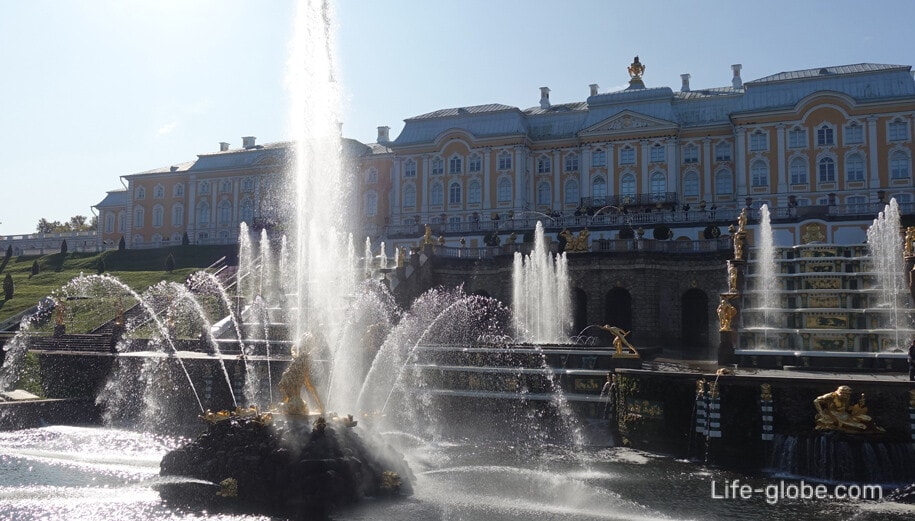
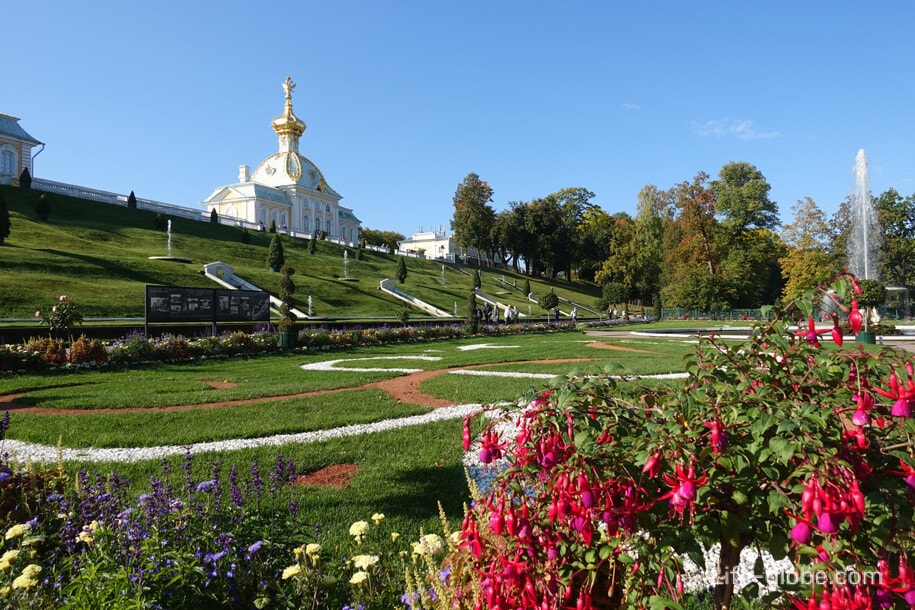
The fountains are open during the summer season.
The grandiose Grand Cascade Fountain, the less noticeable Basket and the Samson Fountain, which has become a symbol of Peterhof, occupy a central place in the park and are the most famous fountains of Peterhof.
These fountains visually represent a single impressive and powerful architectural and water ensemble. It is also one of the most outstanding buildings in the world.
The Grand Cascade Fountain consists of two massive seven-step staircases running down the slope in front of the palace, connected by arches of a Large Grotto and decorated with sculptures.
On the lower terrace of the Grand Cascade, in front of the entrance to the Large Grotto, there is a fountain "Basket".
The Grottos of the Grand Cascade are now a museum that you can visit for a fee.
The Samson Fountain is located in a bucket at the foot of the Grand Cascade and is a symbol of Peterhof. Learn more about the fountain ensemble with photos, videos, and descriptions…
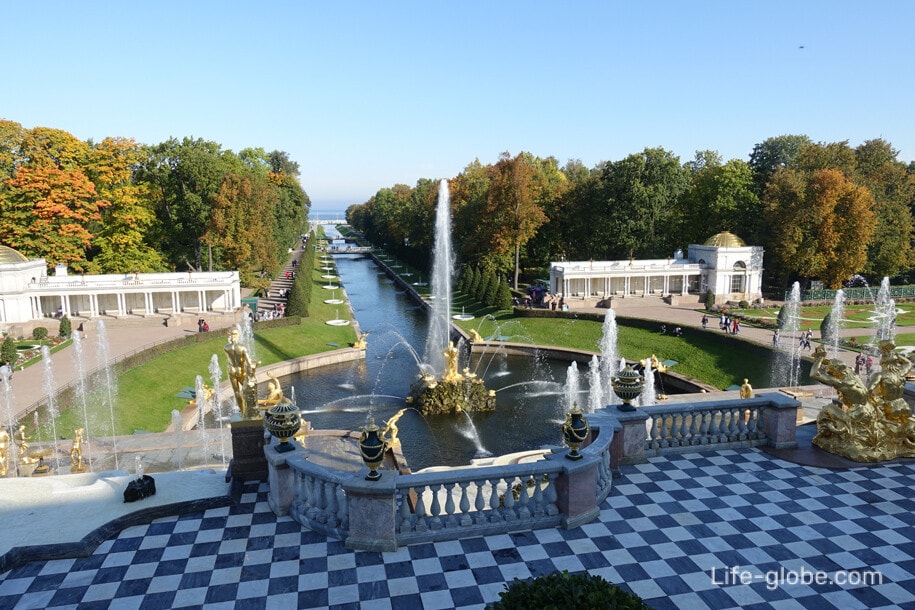
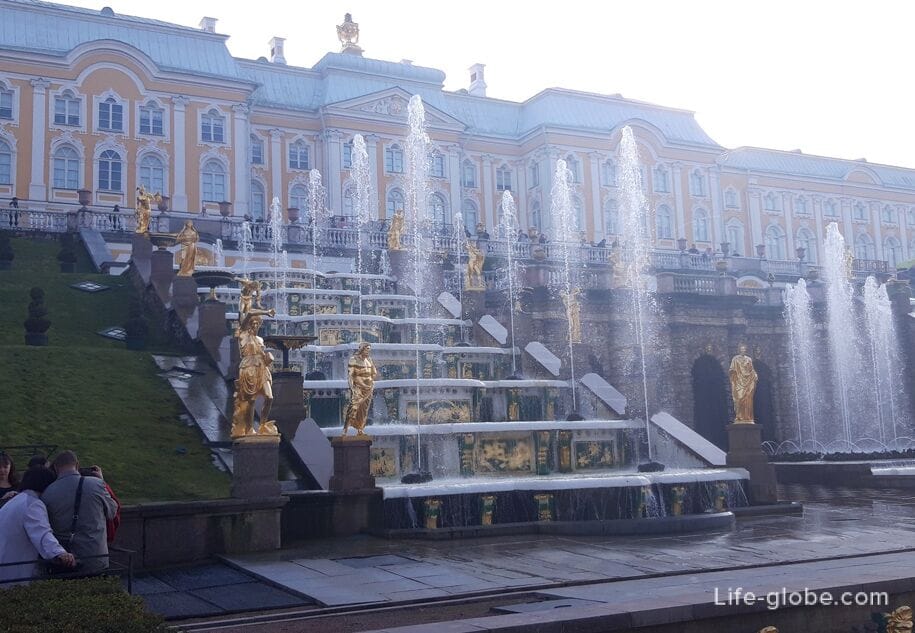
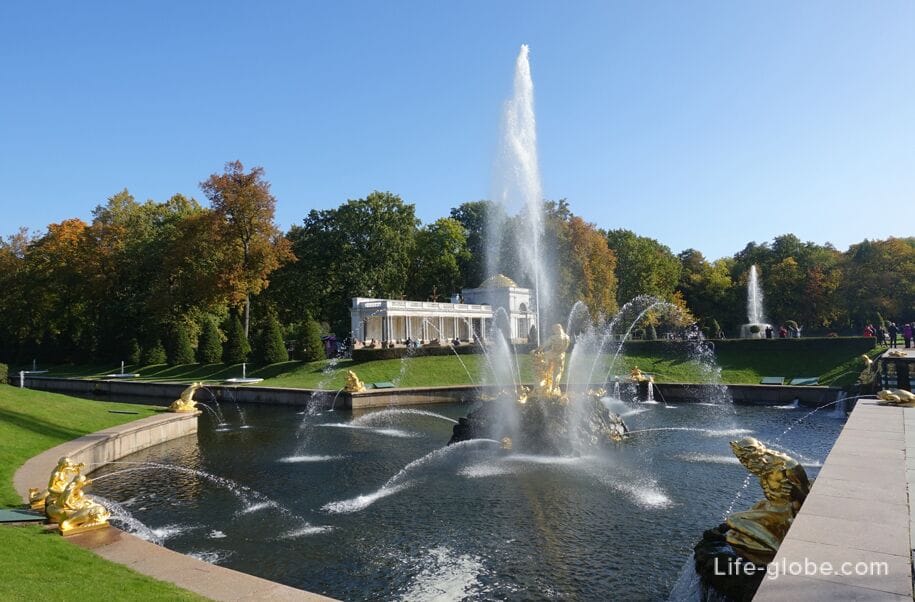
Terraced fountains adorn the slope of the front part of the Lower Park-at the foot of the Grand Palace.
This is a series of fountains consisting of bowls with single-jet fountain water cannons, below which small four-stage cascades are embedded in the slope, the top of which is completed with a triangular pediment and decorated with a gilded bronze mascaron, from which water flows down the steps. At the foot of the cascades, small thin streams beat.
In total, there are ten Terraced fountains in the park.
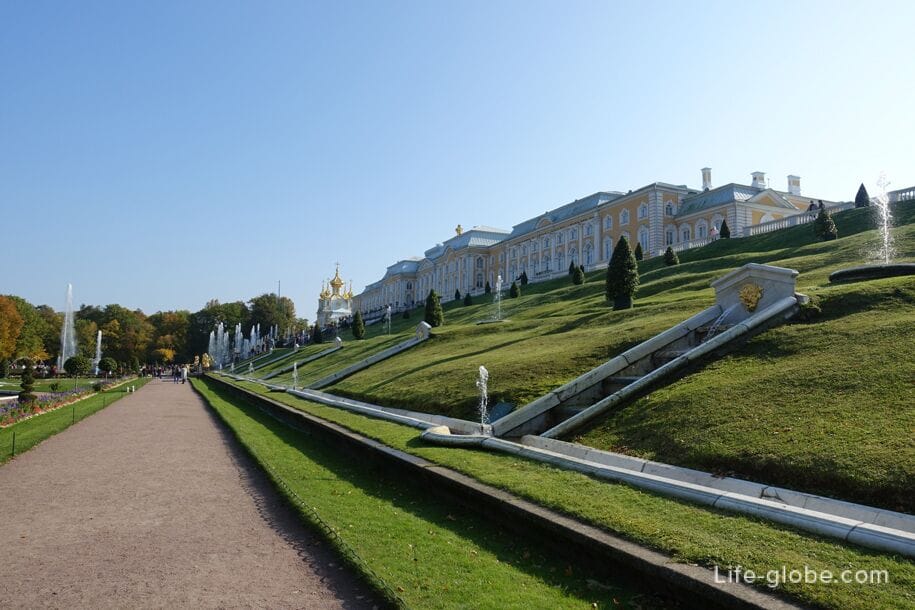
These fountains are two; they are identical. They are located in the central part of the park , one on each side of the Samson fountain.
The fountains were built at the end of 1722 by the architect N. Michetti. The trial launch of the fountains took place in the presence of Peter the Great, who created the Grand Palace and the adjacent Park.
The Chashy fountains are the oldest fountains in Peterhof, which have a second name for the power of the jets - "Big Fountains". And since the work on the hydrotechnical device of the eastern fountain "Bowl" was performed by the Frenchman Paul Sualem, and the western fountain-by the Italians Giovanni and Giuliano Barratini, the eastern fountain is also called "French", and the western fountain - "Italian".
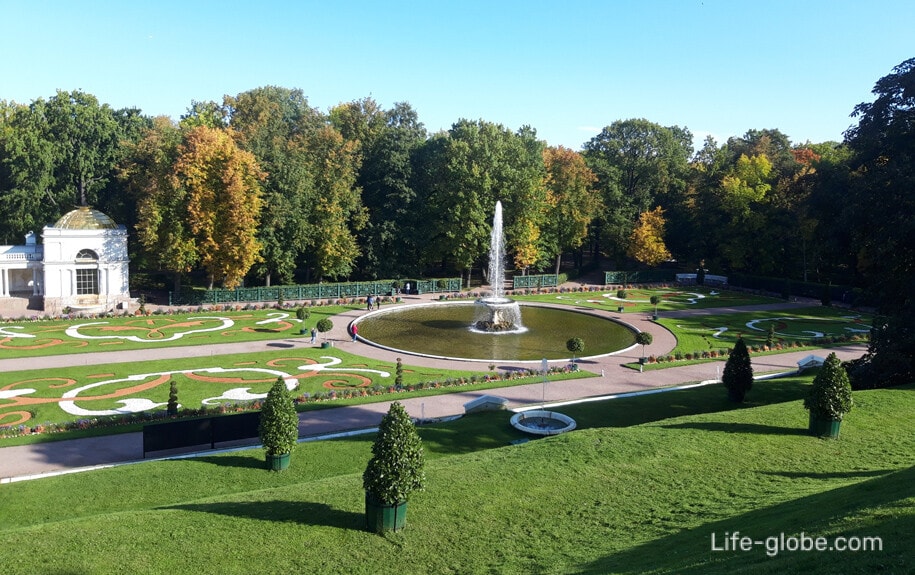
The fountains of the marble benches "Nymph" and " Danaida "are located near the fountains"Bowls".
Fountains in the form of semicircular benches made of snow-white Carrara marble with gilded statues above them were created in the 19th century by A. I. Stackenschneider.
The massive elbows of the benches are made in the form of large volutes, turning into powerful lion paws. Behind the smooth backs, enlivened by relief belts of geometric ornamentation, are pools with marble bowls, in which gilded bronze statues are placed:
- above the west bench stands the figure of a Nymph-a river goddess, a copy of an ancient Roman sculpture of the 3rd century BC, stored in the collection State Hermitage Museum of St. Petersburg;
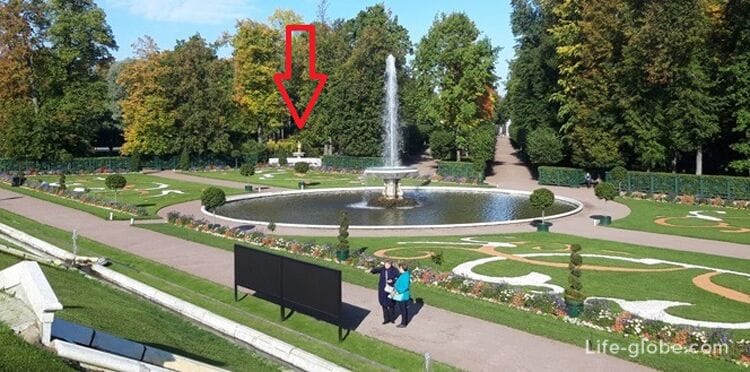
"above the east bench is a statue of Danaida holding a pitcher - one of the fifty daughters of the Libyan king Danaus, who were condemned to fill a bottomless barrel with water forever for the murder of their husbands. The sculpture "Danaida" is made on the model of I. Vitali, who made a copy of the original marble work of the German sculptor of the 19th century. Rauha.
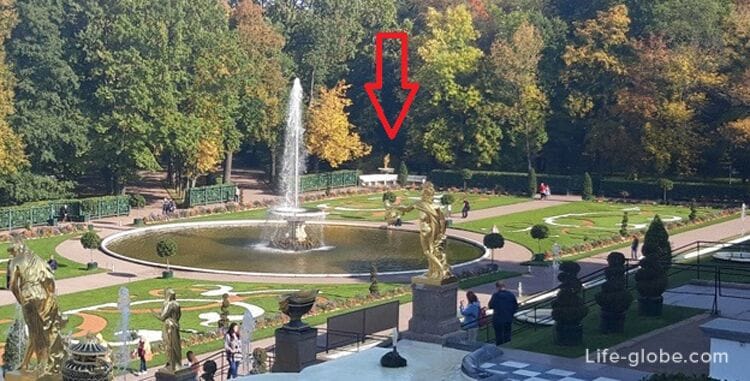
The sea (Samsonovsky) channel originates from the bucket with the Samson fountain and leads to the pier in the Gulf of Finland.
Initially, the canal served as the main entrance to the territory of the palace complex. Guests arrived in Peterhof by ship, after which they were transferred to boats and light vessels that passed through the channel to the bucket, which then served as a harbor (the Samson fountain under Peter I was not yet there).
Along part of the canal runs an Alley of Fountains, which has 22 fountains ("Niche" fountains), and the canal itself is crossed by pedestrian bridges.
Together, the Sea Channel and the Fountain Alley make up one of the main attractions of Peterhof, emphasizing its seaside character.
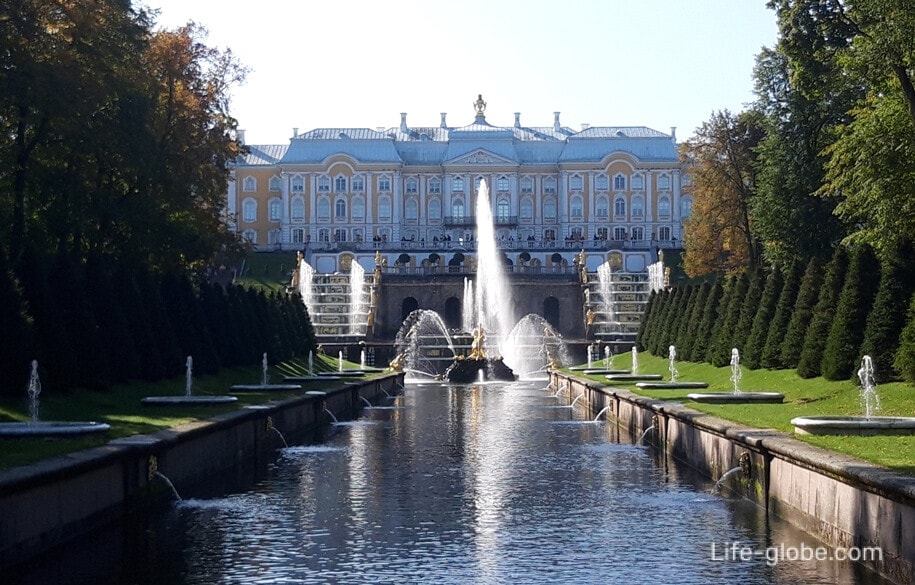
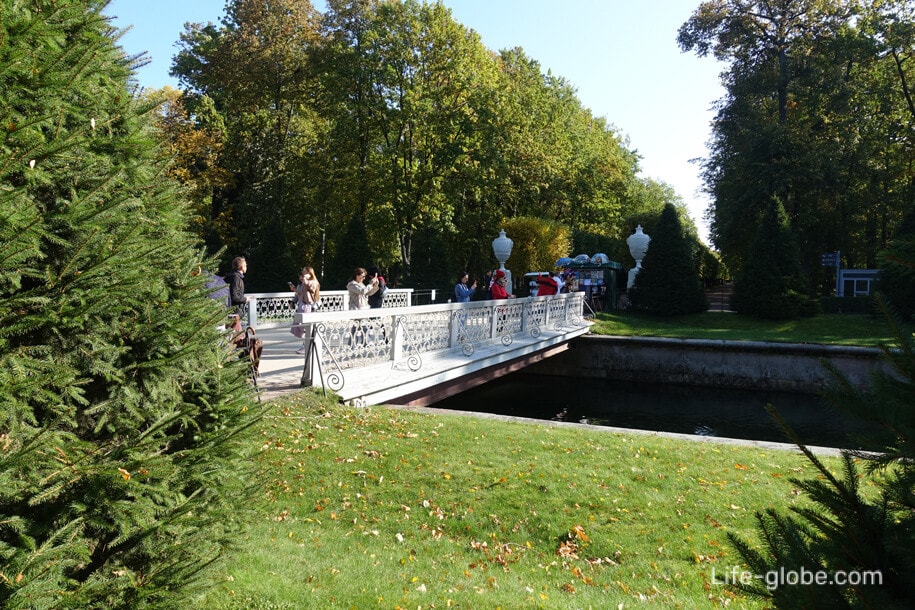
The history of the fountain "Favoritka" is closely connected with the aforementioned Alley of Fountains.
Initially, 22 fountains were placed along the alleys of the Marine Canal of the park, which formed the decor of the main entrance to the palace. The fountains were placed in the niches of the trellis fences on the sides of the alleys along the canal, so they were called "Niche". Peter I planned to decorate these fountains with sculptural compositions on the themes of Aesop's fables, so that they would have an educational character and be interpreted as moral edification and satire on the enemies of Russia. However, this plan was not implemented.
In 1735, the Niche fountains were moved to the very edges of the canal and new pools were made for them.
And a reminder of Peter's plan to give the fountains an echo of Aesop's fables, today in the Lower Park there is only the fountain "Favorite" or the fountain "Favorite", in the pool of which there are moving and making sounds figures of ducks and dogs. Learn more about the Favorite fountain with photos and videos…
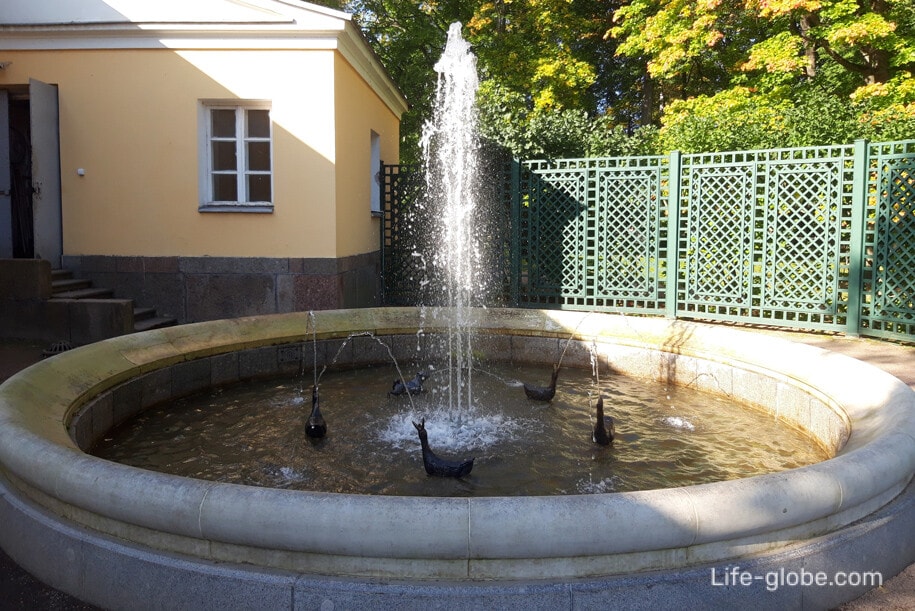
On Marlin Alley, which crosses the Sea Channel of the park, in the eastern (fountain Eve) and western (fountain Adam) sides of the park, equidistant from the channel, there are fountains Adam and Eve.
These two fountains are paired and differ only in the marble central figures, which are installed on high pedestals in the centers of the fountain pools. Near the plinths there are sixteen small tubes, from which water jets beat to a height of seven meters, and the water is not sprayed, but splits into separate large drops that are clearly visible from afar.
In the 18th century, the fountains were surrounded by trellis gazebos, which served as shelters from the weather and for recreation on hot sunny days. Today, elegant modern structures remind us of gazebos. Learn more about the Adam and Eve fountains…
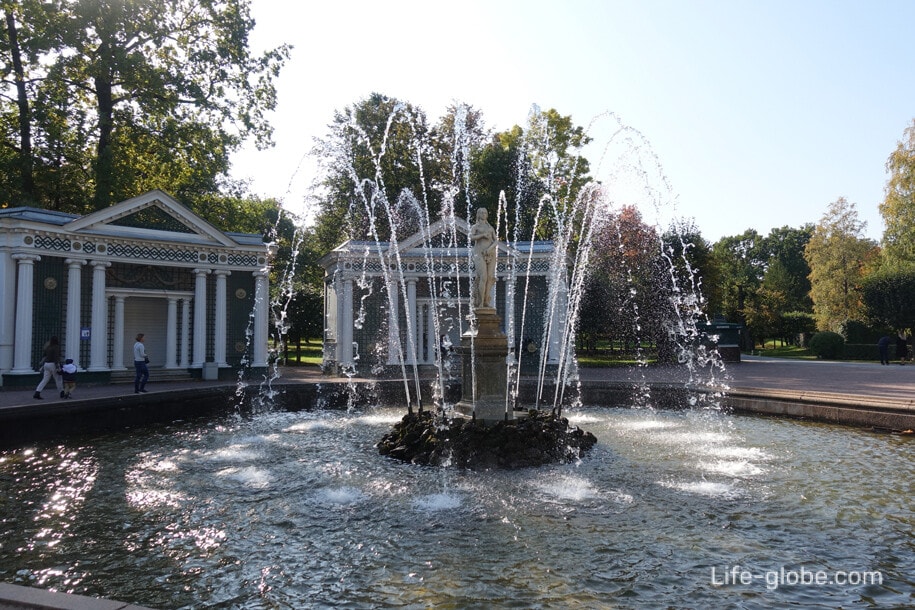
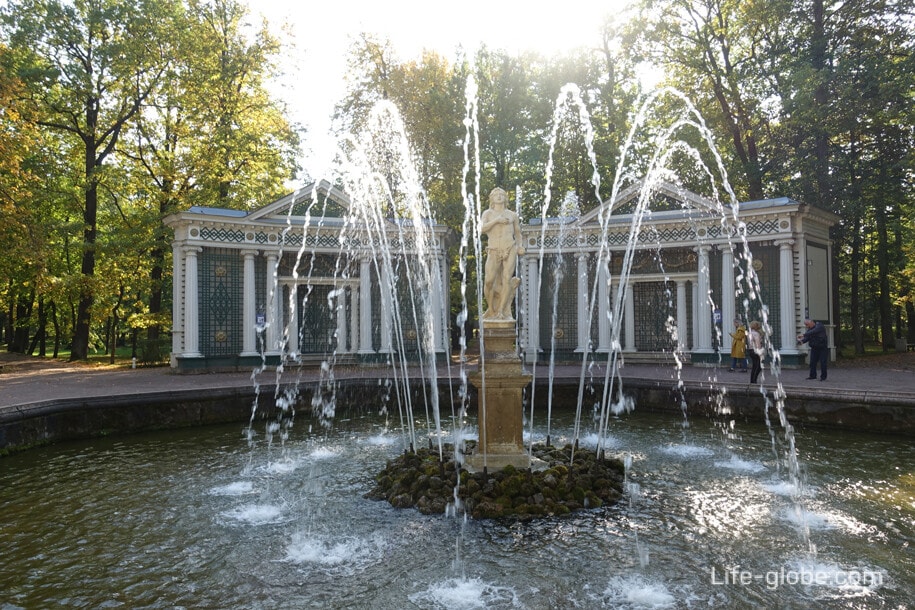
In 1801, designed by architect and painter Andrey Nikiforovich Voronikhin, near Hermitage Pavilion The Hermitage Cascade fountain was built, which is now known as the Lion Cascade Fountain.
The fountain has a late classicist style. It consists of a monumental colonnade set on a high granite plinth. From the 12 bowls located between the columns of the colonnade, water jets beat. In the lower part of the fountain, on the plinth, there are mascarons, from which water streams flow into the fountain pool. On the sides of the colonnade of the fountain, on pedestals, there are bronze figures of "guard" lions, from the mouth of each of which streams of water flow.
In the center of the fountain is decorated, located on a granite "rock", a statue of the nymph Aganippe-the patroness of the eponymous spring at the foot of Mount Helikon. According to legend, people drinking from this spring were poetically inspired. The statue was created on the model of F. P. Tolstoy. Learn more about the Lion Cascade with photos and videos…
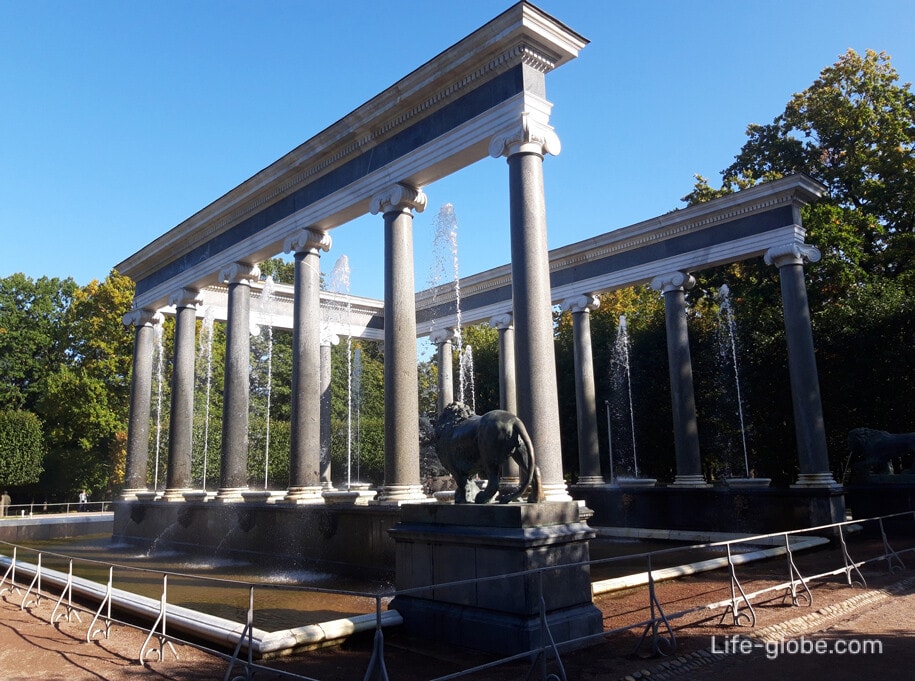
The Golden Mountain Cascade is one of the cascading fountains of the Lower Park, which is the most elegant in the western part of the park and is part of the overall ensemble of the Marli Palace.
According to its location, the fountain is also called the "Marlin Cascade".
The fountain is located on the natural slope of the park and is made in the form of a multi-stage descent, decorated with mascarons and sculptures that trace the theme of sea rule.
The stepped descent of the fountain is framed by the sides, along which stairs are laid.
In the lower central part of the cascade, in a small marble pool, there is a marble sculpture-a statue of Flora-the goddess of spring and the renewal of nature. Learn more about the Golden Mountain cascade with photos and videos…

Menagerie fountains adorn the stalls at the foot of the Golden Mountain cascade.
The fountains were created in 1722-1724 by the architect N. Michetti.
These are two identical fountains, having round bowls of pools, from the center of which a powerful jet of water shoots up. The water jet of the fountains rises up to 15 meters and is clearly visible from afar.
With such a visual force of the jets, the water in the fountains is consumed sparingly. The very word "Menager" comes from the French "menager" - to save. Learn more about Menagerie fountains with photos and videos…
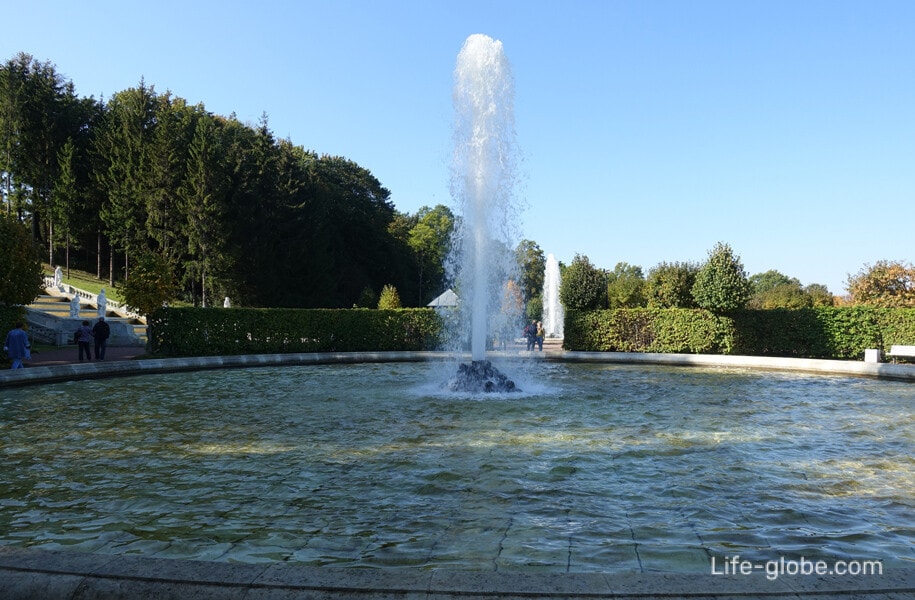
Near the two above-mentioned fountains, along the alley on the shore of the Marlin Pond, there are miniature fountains "Tritons-bells".
The fountains consist of sculptures of four identical newt boys standing in small pools and holding flat tipped bowls above their heads, from which water flows in the form of water bells into the pools of the fountains.
The Tritona fountains use water coming from two Menager fountains. Learn more about Tritona-kolokola fountains…

In the north-eastern zone of the western part of the park, in a natural green environment, there are ponds: Evinsky and Pesochny.
The man-made Sand Pond is decorated with a small but fascinating Whale fountain. Learn more about the fountain and pond…
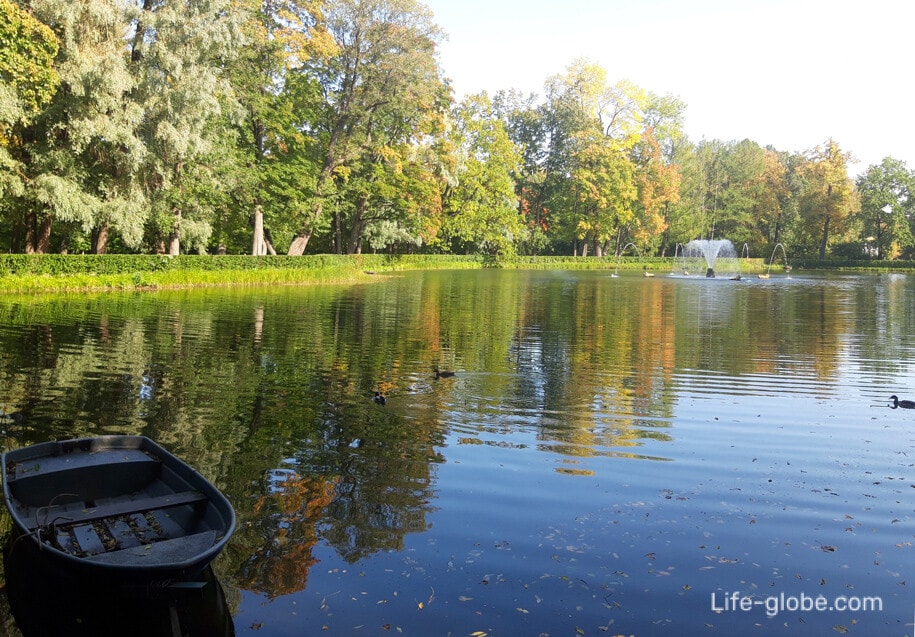
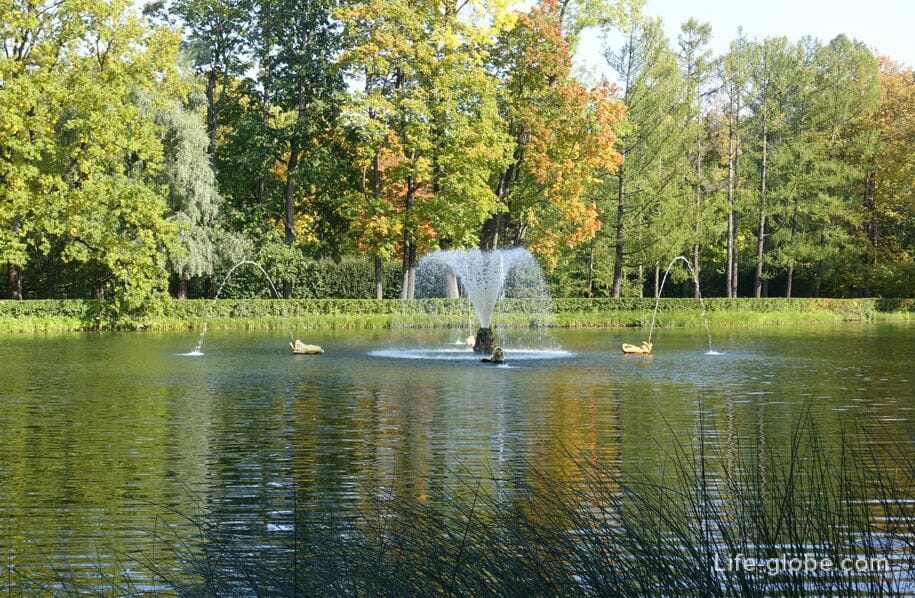
Four fountains "Bells" and a powerful fountain "Sheaf" are located in the eastern part of the park, in the Garden of Montplaisir, near the Palace of Montplaisir. Fountains are part of a single ensemble of the garden and therefore are not perceived separately.
The Montplaisir Garden is divided into four parterres, the center of each of which is decorated with a fountain " Bell». In the center of each of the four fountains there are gilded sculptures:
- the young god Apollo, called "Apollino" and representing a copy from the ancient original of the 4th century BC.;
- Psyche-a copy of the original, made by the Italian sculptor of the classical era Antonio Canova;
- "The Faun with the kid" - a copy from the ancient original of the first century BC.;
- "Bacchus" - a copy of the work of the Italian sculptor and architect of the High and Late Renaissance-Jacopo Sansovino.
Fountains also differ in their base. Two pedestals have the shape of a vase with relief acanthus leaves, and the other two-the shape of columns with flutes-vertical recesses, grooves on the trunk of the column.
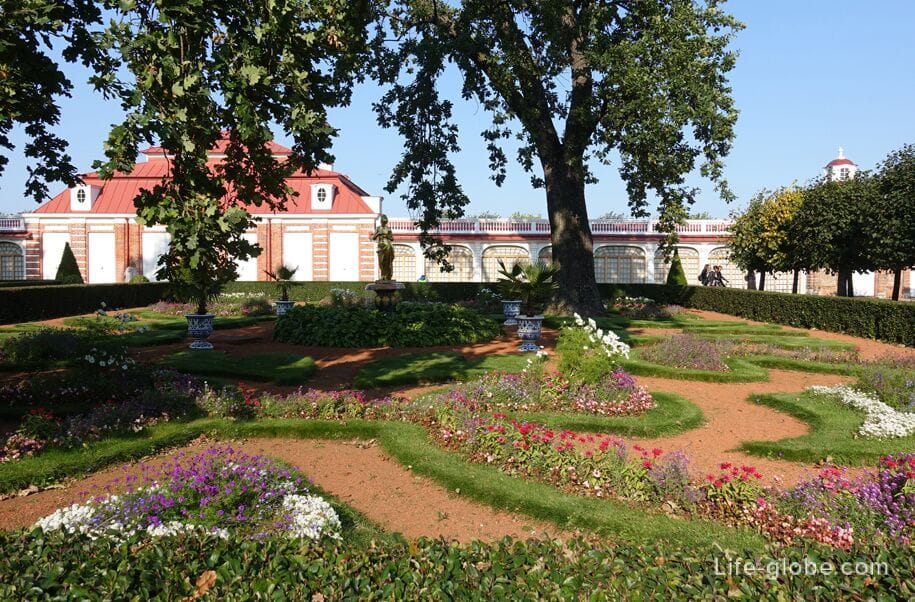
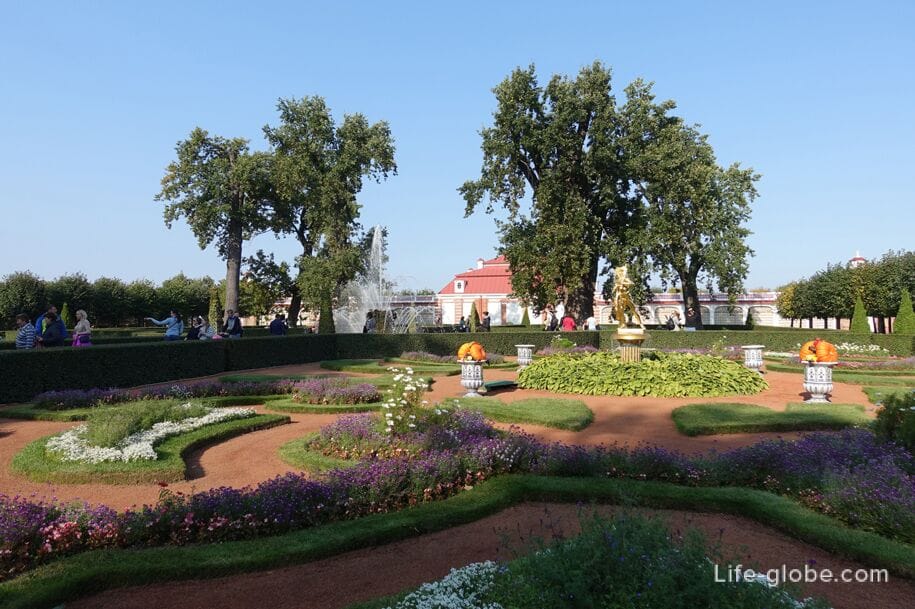
In the center of the garden, between the four parterres, there is a fountain "Sheaf".
This powerful and magnificent fountain was designed by architect N. Michetti according to the drawing of Peter the Great. The fountain was launched in 1723.
The fountain is placed in a deep pool with a diameter of 12 meters. The cordon of the fountain is carved out of Pudost stone and decorated with tuff, and the bottom of the pool is lined with black and white marble slabs. From the tuff pedestal, located in the middle of the pool, a central jet of water flows to a height of four and a half meters, around which twenty-four inclined jets, arranged in two tiers, beat. They resemble a large sheaf of heavy ears, showering transparent grains.
In Russia, the sheaf was considered a symbol of fertility and wealth, and in the language of allegories of the 18th century, this fountain became the personification of the power and prosperity of the Russian Empire. Read more about the Montplaisir Ensemble with photos and videos…
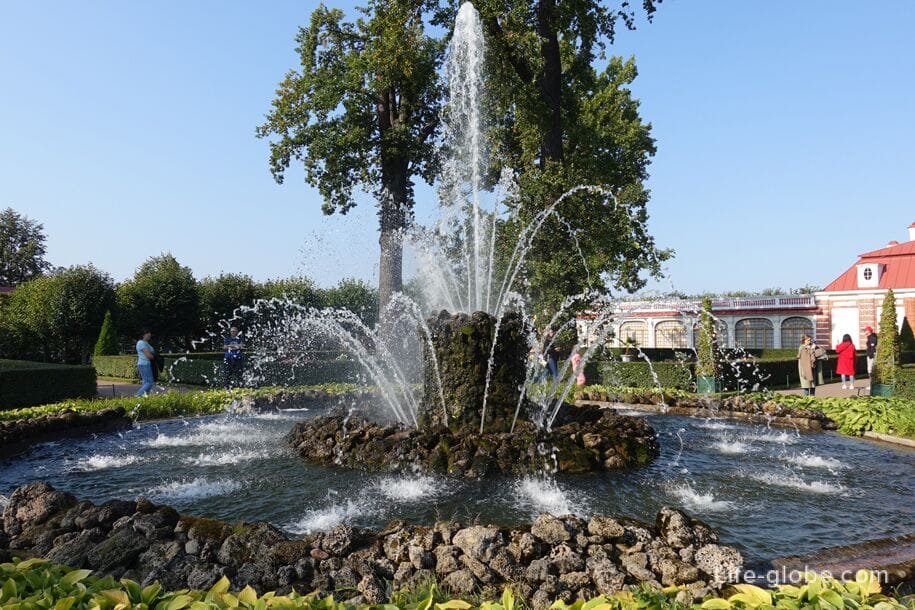
Roman fountains - an ensemble of two fountains with the same design and decoration.
The name of the fountains "Roman" is due to the fact that the fountains in the composition resemble stone water cannons in Rome on the square in front of St. Peter's Cathedral.
The fountains appeared in 1739, designed by architects I. Ya. Blank and I. P. Davydov.
Today, the fountains are among the most impressive, large and beautiful in the park. Each of the fountains has a lower pool and two tiers, as well as five water cannons. The height of the fountains is more than 10 meters. Learn more about Roman fountains with photos and videos…

The cascade fountain "Chess Mountain" is located on the natural slope of the park, near the Roman fountains.
Along the slope run the drain steps of the fountain, painted with black and white squares in a checkerboard pattern. Hence the name of the fountain - "Chess".
The upper part of the fountain is made in the form of a grotto (fountain peak), the entrance to which is guarded by three painted sculptures of winged dragons. From the mouths of the dragons, jets of water flow, which slide along the four waterfall slopes, and an openwork curtain covers the entrance to the lower grotto - they flow into the fountain pool.
On both sides of the stepped slopes of the cascade are stairs, on the sides of which on high stone pedestals are marble figures of the ten ancient gods. Learn more about the Chess Mountain cascade with photos and videos…
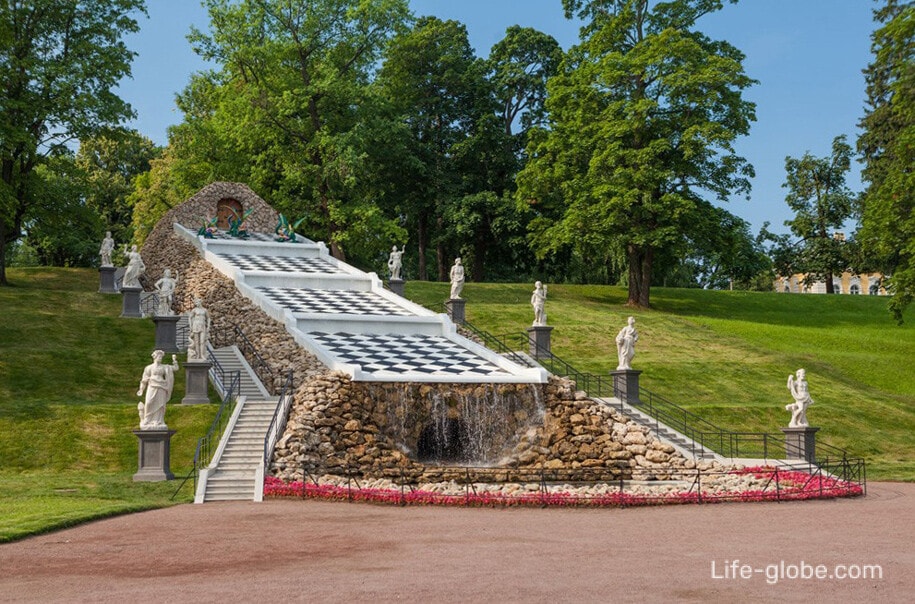
The fountain " Sun " adorns the Menagerie Pond, which was originally part of the menagerie garden created by Peter the Great.
Under the Empress Catherine II, designed by architects AND. Yakovlev and Yu. Felten arranged a royal bath in the pond. The fountain was redesigned and named "The Sun" after the pattern of the jets of the central part of the fountain: on a round pedestal decorated with sixteen gilded dolphins, a bronze column was installed, completed with gilded disks, and a mechanism with a water wheel was hidden in the pedestal.
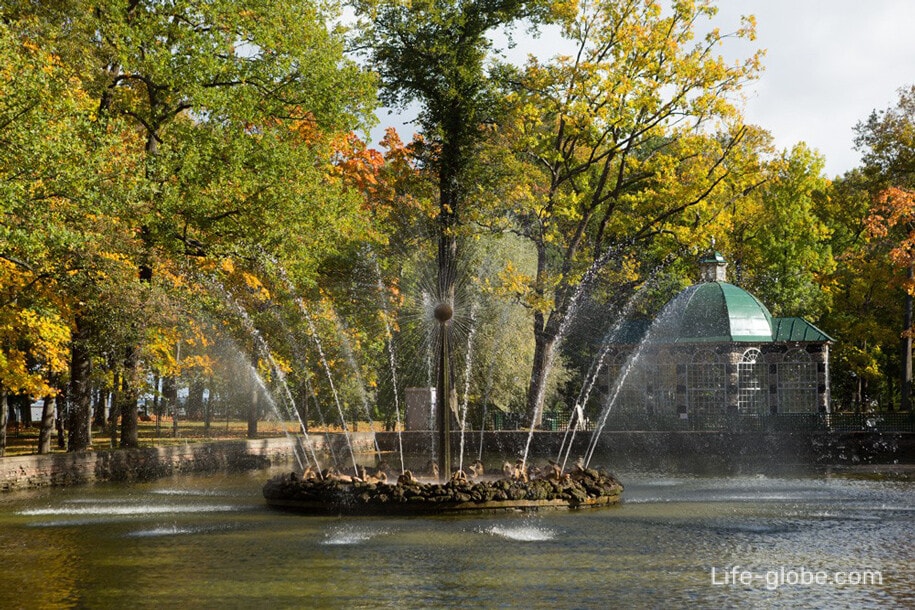
The Triton Fountain is also known as the Orangery Fountain, as it is located in the Orangery Garden near the Large Orangery.
Fruit trees, vegetables, and flowers were grown in the garden; in the center was a pool from which the gardeners took water for irrigation. In 1726, according to the plan of Peter I, the architect T. Usov decorated the pool with a fountain "Triton".
The sculptural group "Triton tearing the mouth of a sea monster", made according to the model of B. K. Rastrelli, represents an allegory of the triumph of Russia in the struggle for the Baltic Sea. Triton represents the young Russian fleet, which inflicted a decisive defeat on the Swedish squadron at Cape Gangut on July 27, 1714. The sea monster refers to the fleet of Charles XII. Four sculptures of a turtle in the fountain, which in fear seem to run in different directions, resemble the infidel allies of the Swedish king.
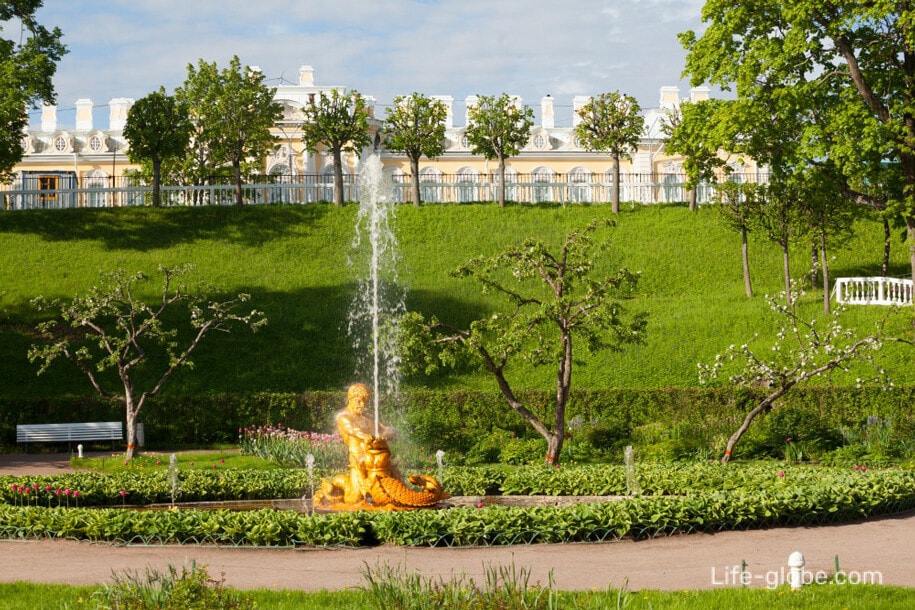
Fountains-firecrackers are allocated to a separate group of fountains in the Lower Park.
Fountain-firecracker-water fun, - a kind of hidden fountain with a comic surprise, disguised as familiar objects or hidden in the landscape, and the idea of which is that the water jets of the fountain appear unexpectedly and spray visitors, thereby creating a playful mood and immersing guests in the atmosphere of the game.
Fountains-firecrackers were one of the frequent elements of the ceremonial residences of the regular park style, including such fountains were created in the Lower Park under Peter I. The emperor liked to amuse himself by watching hidden fountains spray the expensive clothes of high-ranking and noble guests of the royal residence.
Only in the Lower Park are seven fountains, firecrackers, five of which (Tree, oak, Umbrella, Water, road and Sofas) are located near each other in the Eastern part of the Lower Park; and two fountain-crackers ("Table with sprinkling" and "Water curtain") - in the caves of the Grand cascade fountain in Central Park. Learn more about all the firecracker fountains in the Lower Park with photos and videos…
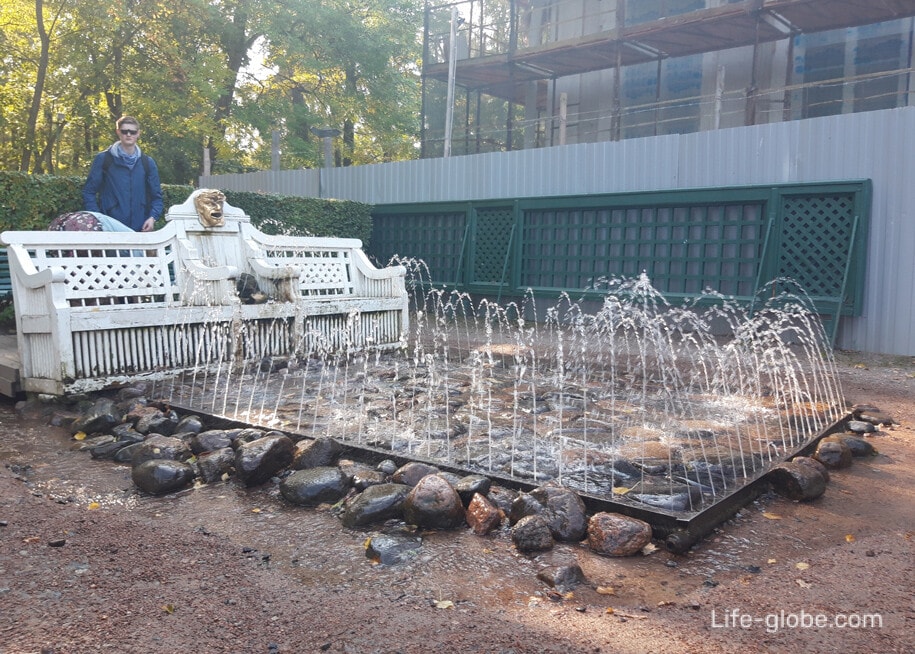
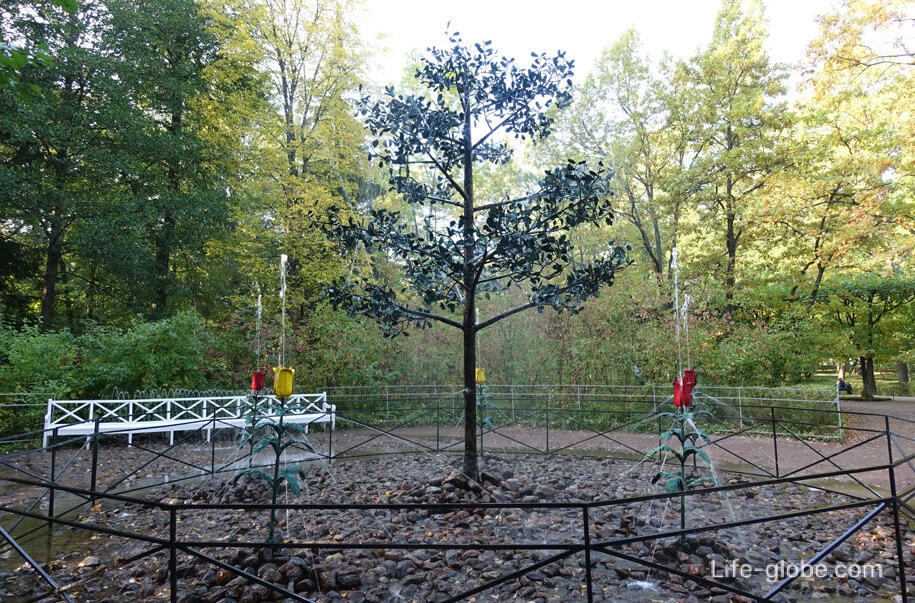
The Pyramid Fountain is one of the most powerful, beautiful and original fountains in the Lower Park of Peterhof.
In addition to its beauty and power, the Pyramid fountain is considered the most water-rich, since it consumes about 100 liters of water in one second.
The fountain is a four-sided seven-stage pyramid, which is completely formed by 505 powerful water jets, which beat with such force that at first glance you can not even imagine that the obelisk consists entirely of water. Learn more about the Pyramid fountain with photos and videos…
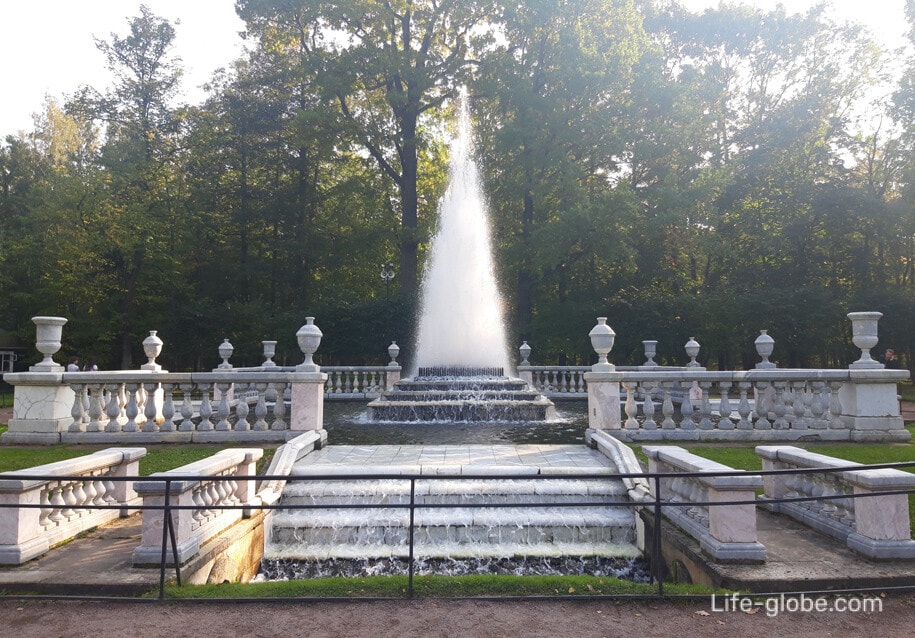
The labyrinth was created in the first quarter of the 18th century by order of Peter the Great. In the plan, it is a rectangular area with an oval platform in the center, from which eight small alleys diverge, the space between which is formed by bosquettes.
All the paths and borders of the maze are framed by trellises made of bush lime trees growing along the wooden trellises. In the bosquets, apple trees are planted and small areas with niches for garden benches are arranged.
In the center of the maze is a swimming pool with a fountain of the menagerie type, which appeared in this place in the middle of the 18th century, according to the plan of the new decorative decoration of the Maze created by F.B. Rastrelli.
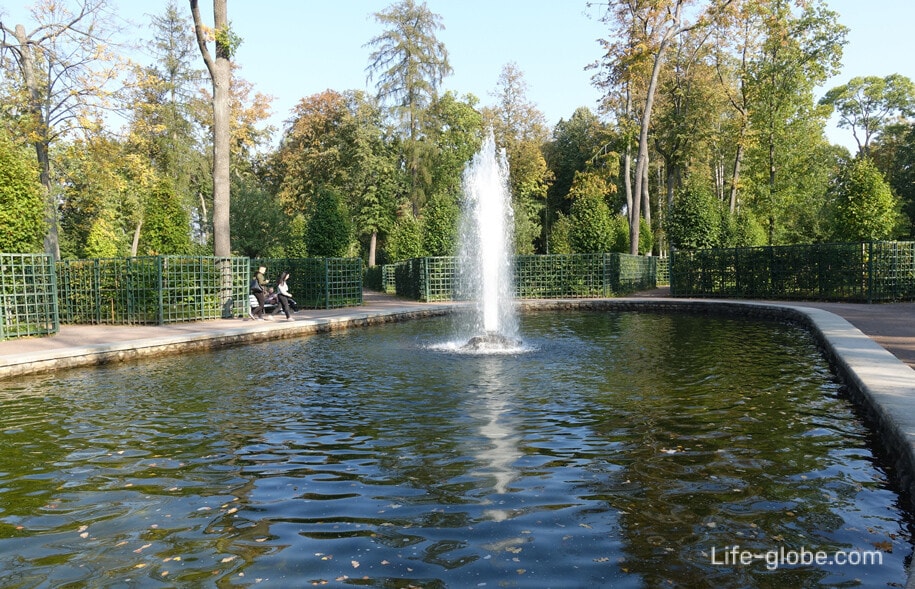
The Lower Park of the Palace and Park Ensemble "Peterhof" belongs to the State Museum-Reserve "Peterhof".
The fountains of Peterhof are closed for the winter (do not work) - from about the middle of October until the 20th of April.
In winter, when the fountains are not working, the entrance to the Lower Park is free (free of charge).
During the summer season, the fountains are open and the entrance to the park is paid.
Entrance to each of the park's museums is paid. Museum visits are not included in the price of the entrance to the Lower Park - they are paid separately.
Tickets to the park and museums can be purchased at the ticket offices located directly near the entrances to the park or in advance-online on the official website.
We recommend that you check the opening hours of the park and museums, as well as the conditions for visiting and the cost of tickets, on the website of the State Museum-Reserve "Peterhof": peterhofmuseum.
You can visit Peterhof with one of the excursions
All the ways to get to Peterhof from St. Petersburg (the airport and the city center) can be found here →
Near the Palace and Park Ensemble "Peterhof" you can stop
The 4-star Novy Peterhof Hotel features a restaurant, a bar, parking, a tour desk, a spa area with an indoor pool, a gym, a steam bath, a Finnish cedar sauna and an aroma sauna.
The rooms are decorated in a modern style and feature a TV with satellite channels, free Wi-Fi, a safe, bathrobes and slippers, a hairdryer and free toiletries. Some rooms have a seating area.
The room rate can include: breakfast, breakfast + dinner or breakfast + lunch + dinner. Link to the hotel
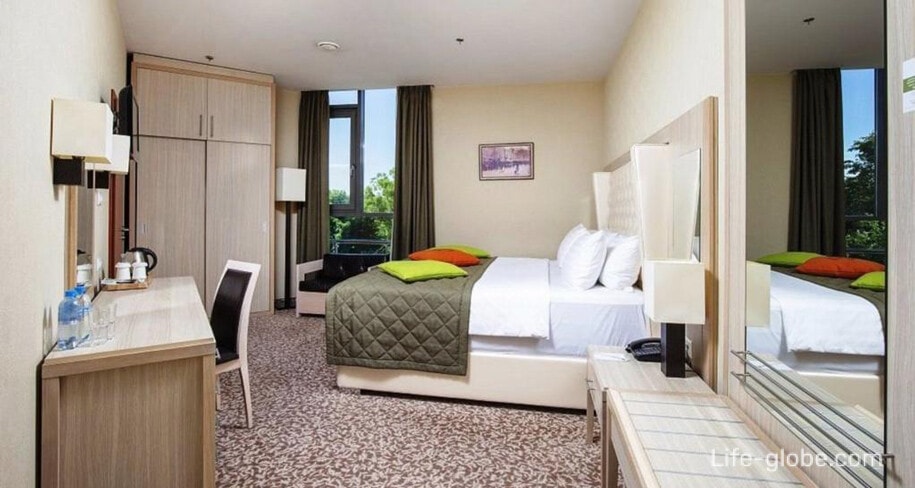
EGO-LOFT Apartment (Holgin Pond) they offer views of the lake and the city.
The apartmentfeatures air conditioning, a balcony, free Wi-Fi, a flat-screen TV, a washing machine, a bedroom, a kitchen with a dishwasher and a microwave, and a bathroom with a hairdryer and free toiletries. Link to the apartment
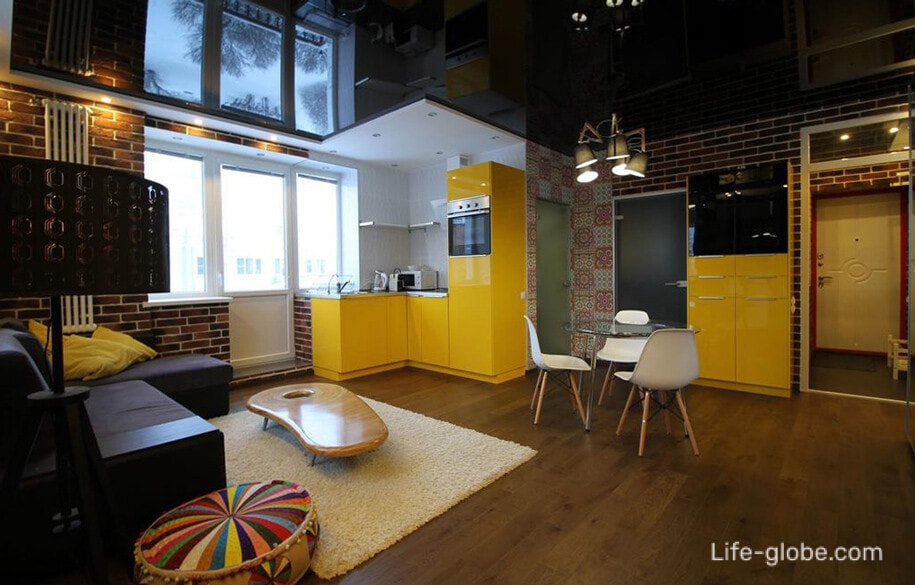
Severnaya Venezia Apartment с features a balcony with lake views, free Wi-Fi, a children's playground, a garden and a shared lounge.
The apartmentfeatures a bedroom, a flat-screen TV with cable channels, an equipped kitchen with a microwave and a refrigerator, a washing machine, and a bathroom with a shower. Link to the apartment
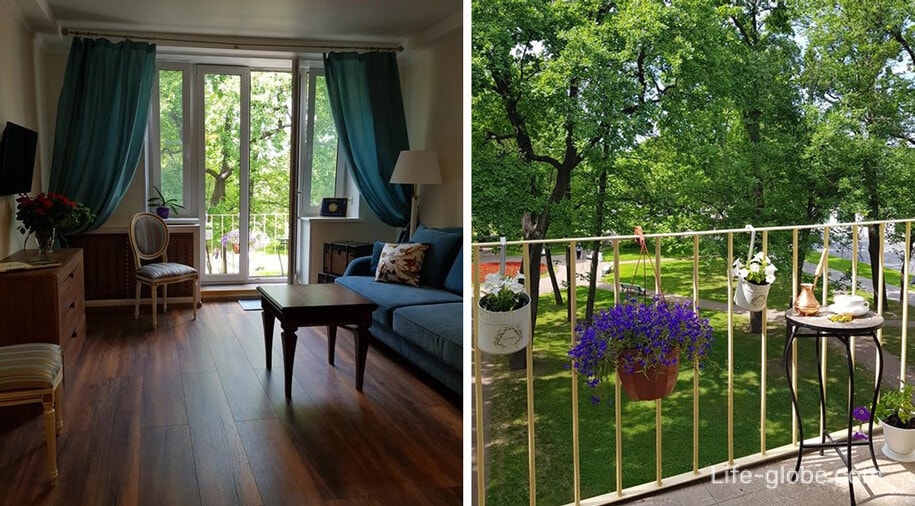
All accommodation facilities in St. Petersburg, including in the city center and in Peterhof, can be viewed and booked here